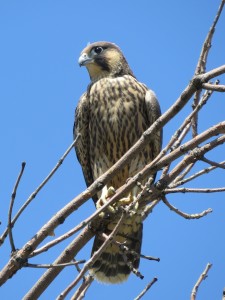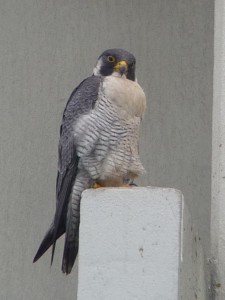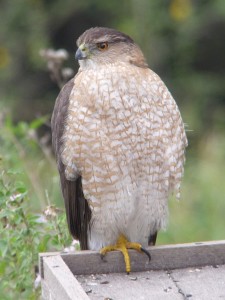We often receive reports from people who believe they have seen a Peregrine Falcon when they actually saw a Merlin, a Cooper’s Hawk or another bird of prey.

Juvenile Peregrine Falcon. The malar stripe, dark brown on juveniles, is already visible.
© Anouk Hoedeman

Adult Peregrine Falcon. Note the dark hood and malar stripe, dark back and pale, barred underparts.
© Anouk Hoedeman

Adult Cooper’s Hawk. Note the dark cap, red eye and reddish-brown markings on the breast. © Anouk Hoedeman

Adult Merlin. This small falcon looks superficially like a juvenile Peregrine, but lacks a distinct, dark malar stripe. © Anouk Hoedeman
This isn’t surprising, because many birds do look alike, and it takes an experienced eye to tell the difference. Females are larger than males, so a female of one species may be similar in size to a male of a similar but larger species. Also, by the time juvenile raptors can fly, they’re the same size as the adults but their plumage as well as the colour of their eyes, beaks and feet may be very different.
So don’t worry or be embarrassed if you’re not sure what you’ve seen. Email us your report, including location, a description of the bird and its behaviour, and we can help you determine whether it was a Peregrine or something else. If you can send a photo, even better.
Here are some tips to guide your identification of Ottawa-area raptors:
- All birds of prey have powerful talons (claws) to catch their prey, and relatively short, curved beaks.
- If it has a single, broad, dark, vertical stripe on each cheek, below the eye, it’s a Peregrine Falcon. This is a called a malar stripe.
- If it has no obvious, single, vertical malar stripe, it’s not a Peregrine. (American Kestrels have thinner, double stripes.)
- If it’s perched on a highrise, radio tower, smokestack or other very tall structure, it may well be a Peregrine.
- If it’s perched on a wire, a fence or a post, it’s almost certainly not a Peregrine.
- If it’s perched in a tree, it may or may not be a Peregrine. They sometimes perch in tall trees near large bodies of water, and juveniles (like the one above) may end up in trees during the fledging period. However, it would be unusual to find one in a tree in your backyard.
- If it’s hunting or feeding in an urban backyard, it’s probably not a Peregrine.
- If it has a nest in a tree, it’s not a Peregrine.
- Merlins and Cooper’s Hawks are the raptors most often seen in Ottawa-area backyards. They also prey on other birds, but both lack the Peregrine’s dark hood and malar stripe.
- Other birds of prey you may see in the Ottawa area include the Sharp-shinned Hawk, Osprey, Bald Eagle, American Kestrel, Red-tailed Hawk, Northern Harrier, Red-shouldered Hawk, Broad-winged Hawk, Rough-legged Hawk, Northern Goshawk and Turkey Vulture.
- If you hear the bird calling, compare the sound to those made by the Peregrine Falcon.
- Cornell University’s All About Birds site is an excellent resource for identification.
- The Peregrine Fund website also has a section on raptors, including identification.
